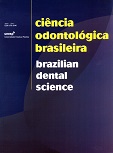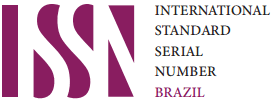Influence of additional polymerization in the microhardness of direct composite resins
DOI:
https://doi.org/10.14295/bds.2007.v10i2.333Resumo
Objective: To evaluate different methods of additional polymerization in the Vickers’ microhardness of three composite resins. Material and Methods: With assistance of a metallic matrix (3 x 4mm), 30 specimens (sps) of each direct resin composite (drc) were prepared, entitled: Filtek Z250(3M ESPE, Saint Paul/MN-USA)(Gr1), W3D(Wilcos, Petrópolis/ RJ-Brazil)(Gr2), and EstheticX (Dentsply/York/PA-USA)(Gr3). All sps were photopolimerized, by the incremental technique, during 40 seconds (Gr1 - n=10: control). After that, 20 samples of each group were divided and half of the samples (n=10) were submitted to the additional polymerization during 15 minutes to 127ºC in autoclave (Gr2) and the other half in stove (Gr3). After all sps were stored in distilled water (37ºC/24 hours). The microhardness was accomplished in digital machine (Future-Tech, FM 700 Model), with 50kg of load. The data obtained (Kg/mm2) were analyzed utilizing the ANOVA Test (2 factors) and Tukey test (p<0.05). Results: The values of mean ± standar deviations obtained were: Gr1a(84,2±5,1), Gr1b (71,6±6,7), Gr1c (89,6±7,4), Gr2a (101,1±6,0), Gr2b (96,4±9,0), Gr2c (112,6±7,3), Gr3a (74,0±6,5), Gr3b (66,0±12,7) e Gr3c (81,7±6,5). The polymerization in stove produced a higher microhardness than the other kinds of polymerization (p<0.05) and the microhardness of the resins statistically differed among them (p<0.05). Conclusion: The additional polymerization of the Filtek Z250 in the stove produced microhardness statistically higher than the others.Downloads
Downloads
Publicado
Como Citar
Edição
Seção
Licença
TRANSFERÊNCIA DE DIREITOS AUTORAIS E DECLARAÇÃO DE RESPONSABILIDADE
Toda a propriedade de direitos autorais do artigo "____________________________________________________________________" é transferido do autor(es) para a CIÊNCIA ODONTOLÓGICA BRASILEIRA, no caso do trabalho ser publicado. O artigo não foi publicado em outro lugar e não foi submetido simultaneamente para publicação em outra revista.
Vimos por meio deste, atestar que trabalho é original e não apresenta dados manipulados, fraude ou plágio. Fizemos contribuição científica significativa para o estudo e estamos cientes dos dados apresentados e de acordo com a versão final do artigo. Assumimos total responsabilidade pelos aspectos éticos do estudo.
Este texto deve ser impresso e assinado por todos os autores. A versão digitalizada deverá ser apresentada como arquivo suplementar durante o processo de submissão.




























